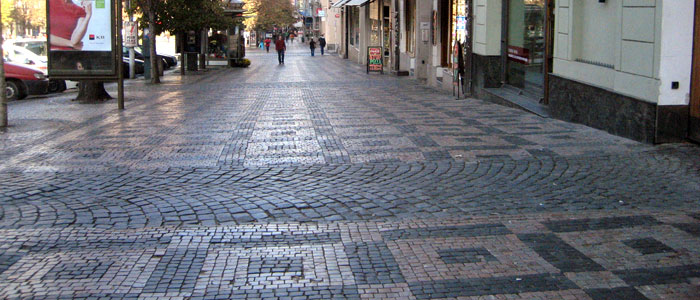Prague, Czech Republic Travel Guide
About Getting Around Attractions Hotels Eats & Nightlife Essentials & Practicals
Accessibility in Prague

Belehradska intersection in Prague 2
Overview: Prague has a reputation of not being wheelchair accessible. I won’t mince words: Prague isn’t the easiest place to get around on wheels, especially the city center. Among some of the challenges are slight to steep hills, sidewalks made of 3 by 3 flat and smooth to rugged stones, brick-like cobblestones (not mounds) in some streets, tram tracks embedded in these cobblestones and lots of buildings with steps. Some of the sidewalks are smooth; some are a bit bumpy. Motorized wheelchairs would fair better than someone who’s not that strong and confined to a manual wheelchair, especially a wheelchair with small front casters made of polyurethane.

Sidewalk in Wenceslas Square, Prague
There are areas that are smoother than others. For instance, Wenceslas Square, which is on Vaclavske Náměstí, has smoother sidewalks than some of the surrounding streets. Not all sidewalks are composed of the 3 by 3 stones and not all streets have those brick-like cobblestones. The further from the city center you go, the more you’ll see concrete sidewalks and blacktop streets.
Prague is a fairly hilly city, an old city that´s been renovating and upgrading its infrastructure the last 5 years. To that end, places are getting easier to get to, especially with the newer, handicap accessible buses.

Cobblestone path in Old Town Square, Prague
Streets
The sidewalks in Prague 1 – 4, especially, have 3 by 3 (apprx) stones held together by cement. These are often rugged stones, though they should be flat. Hills with these will make you work a bit harder of course. Wenceslas Square, which is located on Vaclavske Namesti, has smooth stones. These stones don´t jut out and make it too difficult. They are flat but often have some ridges on the surface.
A lot of the streets themselves have cobblestones that are like loaves of bread or large bricks. Not too round, but make for a bumpy roll over them. Most of the streets where the trams run are embedded with rail tracks. They present grooves that you may have to do a wheelie over them. In addition, these tracks are often combined with the rugged cobblestones.

Crosswalk along Rumunska street in Prague 2
Of course, the stones on the sidewalks and the cobblestones on the streets make for a bumpy ride, especially if your front casters or wheels are small. But, once you´re familiar with the streets and directions, however, you can find the path of least resistance, so to speak; meaning, find the easiest way to get from point A to B. There are a lot of streets with plain cement sidewalks, which are a blessing.
A person in a motorized wheelchair or scooter will find Prague easier to wheel around in than a person in a manual, push wheelchair. Motorized wheelchairs generally have pneumatic, air-filled, fat tires that can take little bumps and grooves. Wheelchairs with solid rubber tires will find Prague bumpy. For my own wheelchair, I use 26 x 1.70 pneumatic tires with some nobbies on them. I don’t max out the air pressure in the tires because too much air pressure makes for a hard and bumpy ride. Plus, curbs are harder to hop with solid tires since they don’t grip the corners of curbs well. You tend to bounce backwards trying to get up a curb with rock solid tires.

At the end of Charles Bridge
Curbs
Most of the curbs dip down for an easy transition. But, there are curbs that are 2 to 3 inches high. This is common everywhere though.
Steps
Lots of steps everywhere but more and more places are building concrete ramps. Wenceslas Square has a lot of accessible places to eat and hang out at. More and more hotels are making their establishments accessible. A lot of apartments aren´t accessible.

Vytah for elevator in Prague
Elevators, Lifts
The word for lift is Vytah. New places have lifts.
Buildings
Prague´s building are old and they have staircases going up or leading down. A lot of restaurants, bars and clubs are down in the ¨cellers¨ to get that comfortable, home feeling.

Belehradska Street in Prague 2
Street Addresses
Street signs and addresses are located high on the corner buildings of streets.
- Red signs indicate the street name
- Blue signs indicate address or building number